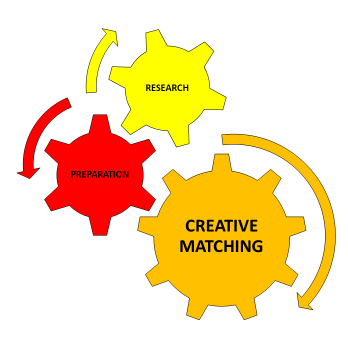
One specific area relevant for NGOs much more than for commercial businesses is fundraising and ways to conduct and communicate it. Here we will focus dominantly on how to tailor your projects to the needs of potential donors – communication part.
The most important thing for your successful communication with the donor will be how much effort you invested into understanding their point of view and how much you managed to customize your offer for them.
So a lot of the advice revolves around doing prior research on the donor, preparing your presentation and pitch and matching it to the key triggers you identified during this research. If you know for instance a certain donor or company you are offering your project to has sustainability on its agenda you will make sure to emphasize how your project is addressing this topic among other things. This does not mean you should invent things if they are not there. If your project does not have a sustainability angle don’t fake it. Think rather about another donor. Or come up with a new project that will be relevant to them specifically.

You can get widen your donor/supporter network if you:
- Look around you for successful companies;
- Look at other organization’s sources;
- Use open and available governmental or other institution sources.
The key message here is: Get into an entrepreneurial spirit!
This might not be something that comes naturally for you as an NGO but the fact that you are not making profit doesn’t mean you don’t need resources to function even more so as you need resources to deal with the topics that are not commercial by nature.
In this sense your key strength is your cause and the emotionality you are able to bring out of it. The importance of the topics you are addressing through your work and the effects this has on society (and users of this potential donor ultimately).
You should position yourself as an ally to commercial companies, someone who helps their users also, to resolve some important challenges they may be facing.
Tips for presenting to potential donors:
- Prep well – find out as much as possible about the person/company and customize the presentation to them
- Do storytelling from their perspective
- Emphasize the benefits
- Cover both the rational and the emotional benefits
- Structure – background, current project proposal, benefits for them, additional details on execution, recap, close
- If you are asking for a specific figure, name it
- Keep it simple – don’t overcomplicate
- Bulletproof with elevator pitch
An additional form of fundraising that has been gaining popularity in the past years is crowdfunding.
Crowdfunding is a method of raising capital through the collective effort of friends, family, customers, and individual investors.
This approach taps into the collective efforts of a large pool of individuals—primarily online via social media and crowdfunding platforms—and leverages their networks for greater reach and exposure.
Types of Crowdfunding
Which crowdfunding method you select depends on the type of product or service you offer and your goals for growth.
⊛ Donation-Based Crowdfunding
Broadly speaking, you can think of any crowdfunding campaign in which there is no financial return to the investors or contributors as donation-based crowdfunding. Common donation-based crowdfunding initiatives include fundraising for disaster relief, charities, nonprofits, and medical bills.
⊛ Rewards-Based Crowdfunding
Rewards-based crowdfunding involves individuals contributing to the business in exchange for a “reward,” typically a form of the product or service the company looking for funds offers. Even though this method offers backers a reward, it’s still generally considered a subset of donation-based crowdfunding since there is no financial or equity return. This approach is a popular option on Fundable, as well other popular crowdfunding platforms like Kickstarter and Indiegogo, because it lets business-owners incentivize their contributor without incurring much extra expense or selling ownership stake
⊛ Equity-Based Crowdfunding
Unlike the donation-based and rewards-based methods, equity-based crowdfunding allows contributors to become part-owners of the company by trading capital for equity shares. As equity owners, contributors receive a financial return on their investment and ultimately receive a share of the profits in the form of a dividend or distribution. By the nature of the operating business model this type of crowd funding is not applicable for NGOs.
Popular crowdfunding platforms:
1. Kickstarter
Kickstarter is a site where creative projects raise donation-based funding.
2. Indiegogo
While Kickstarter maintains a tighter focus and curates the creative projects approved on its site, Indiegogo approves donation-based fundraising campaigns for mostly anything — music, hobbyists, personal finance needs, charities and whatever else you could think of (except investment).
3. Crowdfunder
Crowdfunder.com is the platform for raising investment (not rewards), and has a one of the largest and fastest growing network of investors.
4. RocketHub
Rockethub powers donation-based funding for a wide variety of creative projects.
What’s unique about RocketHub is their FuelPad and LaunchPad programs that help campaign owners and potential promotion and marketing partners connect and collaborate for the success of a campaign.
5. Crowdrise
Crowdrise is a place for donation-based funding for Causes and Charity. They’ve attracted a community of do-gooders and fund all kinds of inspiring causes and needs.
Obviously crowdfunding is an attractive option as it allows you to collect needed funds in smaller quantities from a variety of supporters not burdening any individual one with an amount they would sweat over but the execution, especially through online platforms, is not that easy and requires in depth evaluation and familiarity with a number of legal and financial matters so “don’t try this at home” just for fun.
